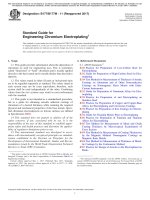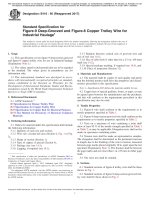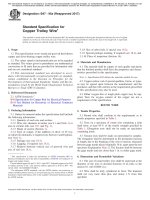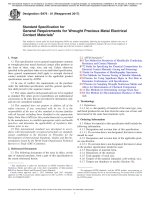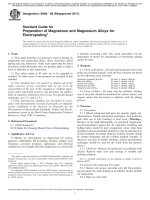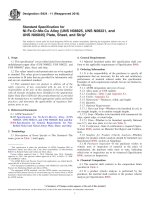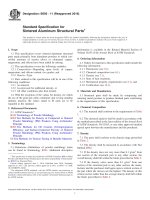Astm b 177 b 177m 11 (2017)
Bạn đang xem bản rút gọn của tài liệu. Xem và tải ngay bản đầy đủ của tài liệu tại đây (121.58 KB, 6 trang )
This international standard was developed in accordance with internationally recognized principles on standardization established in the Decision on Principles for the
Development of International Standards, Guides and Recommendations issued by the World Trade Organization Technical Barriers to Trade (TBT) Committee.
Designation: B177/B177M − 11 (Reapproved 2017)
Endorsed by American
Electroplaters’ Society
Endorsed by National
Association of Metal Finishers
Standard Guide for
Engineering Chromium Electroplating1
This standard is issued under the fixed designation B177/B177M; the number immediately following the designation indicates the year
of original adoption or, in the case of revision, the year of last revision. A number in parentheses indicates the year of last reapproval.
A superscript epsilon (´) indicates an editorial change since the last revision or reapproval.
This standard has been approved for use by agencies of the U.S. Department of Defense.
2. Referenced Documents
1. Scope
2.1 ASTM Standards:2
B183 Practice for Preparation of Low-Carbon Steel for
Electroplating
B242 Guide for Preparation of High-Carbon Steel for Electroplating
B244 Test Method for Measurement of Thickness of Anodic
Coatings on Aluminum and of Other Nonconductive
Coatings on Nonmagnetic Basis Metals with EddyCurrent Instruments
B253 Guide for Preparation of Aluminum Alloys for Electroplating
B254 Practice for Preparation of and Electroplating on
Stainless Steel
B281 Practice for Preparation of Copper and Copper-Base
Alloys for Electroplating and Conversion Coatings
B320 Practice for Preparation of Iron Castings for Electroplating
B322 Guide for Cleaning Metals Prior to Electroplating
B481 Practice for Preparation of Titanium and Titanium
Alloys for Electroplating
B487 Test Method for Measurement of Metal and Oxide
Coating Thickness by Microscopical Examination of
Cross Section
B499 Test Method for Measurement of Coating Thicknesses
by the Magnetic Method: Nonmagnetic Coatings on
Magnetic Basis Metals
B504 Test Method for Measurement of Thickness of Metallic Coatings by the Coulometric Method
B507 Practice for Design of Articles to Be Electroplated on
Racks
1.1 This guide provides information about the deposition of
chromium on steel for engineering uses. This is sometimes
called “functional” or “hard” chromium and is usually applied
directly to the basis metal and is usually thicker than decorative
deposits.
1.2 The values stated in either SI units or inch-pound units
are to be regarded separately as standard. The values stated in
each system may not be exact equivalents; therefore, each
system shall be used independently of the other. Combining
values from the two systems may result in non-conformance
with the standard.
1.3 This guide is not intended as a standardized procedure,
but as a guide for obtaining smooth, adherent coatings of
chromium of a desired thickness while retaining the required
physical and mechanical properties of the base metals. Specified chromium electrodeposits on ferrous surfaces are defined
in Specification B650.
1.4 This standard does not purport to address all of the
safety concerns, if any, associated with its use. It is the
responsibility of the user of this standard to establish appropriate safety and health practices and determine the applicability of regulatory limitations prior to use.
1.5 This international standard was developed in accordance with internationally recognized principles on standardization established in the Decision on Principles for the
Development of International Standards, Guides and Recommendations issued by the World Trade Organization Technical
Barriers to Trade (TBT) Committee.
1
This guide is under the jurisdiction of ASTM Committee B08 on Metallic and
Inorganic Coatings and is the direct responsibility of Subcommittee B08.03 on
Engineering Coatings.
Current edition approved May 1, 2017. Published May 2017. Originally
approved in 1955. Last previous edition approved in 2011 as B177 – 11. DOI:
10.1520/B0177_B0177M-11R17.
2
For referenced ASTM standards, visit the ASTM website, www.astm.org, or
contact ASTM Customer Service at For Annual Book of ASTM
Standards volume information, refer to the standard’s Document Summary page on
the ASTM website.
Copyright © ASTM International, 100 Barr Harbor Drive, PO Box C700, West Conshohocken, PA 19428-2959. United States
1
B177/B177M − 11 (2017)
bath chemistry or the plating conditions, or both, or as a result
of grinding of the electrodeposit can lead to a reduction in the
fatigue life of the electroplated part. If this is a design
consideration, the use of mechanical methods such as shot
peening (see Specification B851 or MIL-S-13165C, or both) or
autofrettage to compressively stress the surface can increase
the fatigue strength. This should be done after any stressrelieving heat treatment.
B558 Practice for Preparation of Nickel Alloys for Electroplating
B568 Test Method for Measurement of Coating Thickness
by X-Ray Spectrometry
B571 Practice for Qualitative Adhesion Testing of Metallic
Coatings
B578 Test Method for Microhardness of Electroplated Coatings
B602 Test Method for Attribute Sampling of Metallic and
Inorganic Coatings
B630 Practice for Preparation of Chromium for Electroplating with Chromium
B650 Specification for Electrodeposited Engineering Chromium Coatings on Ferrous Substrates
B697 Guide for Selection of Sampling Plans for Inspection
of Electrodeposited Metallic and Inorganic Coatings
B762 Test Method of Variables Sampling of Metallic and
Inorganic Coatings
B849 Specification for Pre-Treatments of Iron or Steel for
Reducing Risk of Hydrogen Embrittlement
B850 Guide for Post-Coating Treatments of Steel for Reducing the Risk of Hydrogen Embrittlement
B851 Specification for Automated Controlled Shot Peening
of Metallic Articles Prior to Nickel, Autocatalytic Nickel,
or Chromium Plating, or as Final Finish
F519 Test Method for Mechanical Hydrogen Embrittlement
Evaluation of Plating/Coating Processes and Service Environments
2.2 Military Standard:3
MIL-S-13165B Shot Peening of Metal Parts
3.4 High-Strength Steel Stress Relief:
3.4.1 All steel parts having an ultimate tensile strength of
1000 MPa [150 000 psi, approximately 32 HRC] or greater,
which may contain residual stress caused by various fabrication operations such as machining, grinding, straightening, or
cold-forming, usually will require one of the stress relief bakes
prescribed in Specification B849 prior to electroplating. In all
cases, the duration of the bake shall commence from the time
at which the whole of each part attains the specified temperature. This stress relief is essential if hydrogen embrittlement
from subsequent operations is to be avoided.
3.4.2 Parts having surface-hardened areas that would suffer
an unacceptable reduction in hardness by baking in accordance
with Specification B849 may be baked at a lower temperature
but not less than 130°C for a minimum period of 8 h. Shorter
times at higher temperatures may be used, if the resulting loss
in surface hardness is acceptable.
3.5 Oxidation—All possible precautions should be taken to
prevent oxidation of the metal surface between the final
operations of mechanical preparation and electroplating, particularly with steel substrates. Materials such as aluminum and
titanium have an inherent oxide film on the surface that can
only be removed or minimized just prior to the electroplating
process (see 6.1.1 and 6.1.2). When conditions are especially
unfavorable, definite steps must be taken to meet this important
requirement, including storage in a noncorrosive environment,
or the use of a suitable coating to exclude air and moisture.
3. Substrates
3.1 Engineering chromium may be plated directly to the
surface of a number of commonly used engineering metals
such as aluminum, nickel alloys, cast iron, steels, copper,
copper alloys, and titanium. The bond strengths of the chromium varies with metallic substrate. Nevertheless, if the
procedures cited in the appropriate references are followed, the
bond strength is such that grinding and honing can be conducted without delamination of the coating.
4. Racks and Anodes
4.1 Steel, cast iron, and stainless steel parts to be electroplated may be racked at any convenient stage in the preparatory
process but preferably prior to the final cleaning and etching.
Aluminum, titanium, and certain nickel alloys may need to
have cleaning and etching operations done before racking due
to entrapment of cleaning and etching solutions in the plating
rack which can result in adhesion failures due to seepage
during chromium electroplating.
3.2 Smoothness—The smoothness of the material surface to
be electroplated should be adequate to meet the requirements
of the finished product. Chromium electrodeposits do not
exhibit leveling, and consequently the surface roughness of the
electrodeposit will always be greater than that of the substrate.
Any mechanical operations that can result in grinding checks
or glazing of the metal are detrimental and should be eliminated. The required surface smoothness may be obtained by
suitable chemical, mechanical, or electrochemical procedures.
Depending upon the thickness of the electrodeposit and the
smoothness required of the electrodeposit, grinding of the
electrodeposit may be required.
4.2 See Practice B507 for guidance on rack design, but note
that while the general principles of good racking as used in
other electroplating processes apply, the use of much higher
current densities and the desirability of securing coatings of
uniform thickness and quality on desired areas require rack
construction designs and methods that are much more exacting.
The design of racks for chromium electroplating on the various
base metals previously mentioned for functional use should
provide for the following to the greatest possible extent.
4.2.1 There must be sufficient current-carrying capacity of
both cathode and anode circuits to all parts of the rack.
4.2.2 There must be positive electrical contact to the parts to
be electroplated, to the anodes, and to the tank contact bus bars.
3.3 Fatigue Considerations—Cracking that can occur in
chromium electrodeposits either as a function of the plating
3
Available from Standardization Documents Order Desk, Bldg. 4 Section D, 700
Robbins Ave., Philadelphia, PA 19111-5094, Attn: NPODS.
2
B177/B177M − 11 (2017)
also suitable. If parts have been shot-peened to develop a
compressively stressed surface, it is important to avoid removing that surface by excessive grinding.
4.2.3 There must be uniform current distribution on the
parts to be electroplated. This often requires anodes of special
shapes conforming to the shape of the part or area to be
electroplated.
4.2.4 It may be necessary to use thieves, robbers, or guards,
which are auxiliary metallic conductors placed near points of
abnormally high current density to attract the current away
from such points; and shields, which are parts made of
nonconductive materials and placed to disperse the current in
areas where it tends to concentrate unduly.
4.2.5 It is important to protect areas that are to remain free
of any chromium electroplate by the use of masks made of
rigid, nonconductive materials placed against the substrate, or
stop-offs, which are especially compounded nonconductive
tapes, waxes, lacquers, or plastics for the protection of such
substrates. Lead and aluminum tapes will provide a sharp line
of demarcation between coated and uncoated areas with a
minimum of buildup.
4.2.6 Plugs (conducting and nonconducting) may be used in
holes not requiring electroplating to produce a sharp edge
without grooves around the periphery of the holes.
4.2.7 It is very important to remember that improperly
applied stop-off materials or poorly designed racks can entrap
acids that can cause corrosion of the basis material or contamination of the solutions used in subsequent operations, or both.
4.2.8 Construction materials must be used that are sufficiently insoluble and noncontaminating to provide the desired
rack life.
4.2.9 Components must be placed in such positions that gas
from the parts, rack, thieves, masks, and anodes escapes freely
and does not become entrapped so as to prevent electroplating
on areas that should be electroplated.
6. Deoxidizing and Etching
6.1 Prior to chromium electroplating, most metals need
special preparation in order to achieve maximum adhesion of
the chromium to the substrate. Depending on the type and
nature of the metal and prior surface preparation steps, various
deoxidation and etching methods may be used to activate the
substrate prior to chromium electroplating.
6.1.1 Aluminum—Chromium may be electroplated directly
onto most cast and wrought aluminum materials used for
engineering purposes. Guide B253 offers many useful methods
for preparing aluminum prior to chromium electroplating. The
removal of the ever-present, tenacious oxide film on the surface
of aluminum is what makes electroplating difficult. When using
test methods in which a zinc immersion film is applied to the
aluminum surface for protection against oxide formation, the
article to be plated must enter the chromium-plating solution
under live current.
6.1.2 Titanium—Like aluminum, titanium has an everpresent tenacious oxide film that must be removed prior to
plating. Practice B481 offers many ways to prepare titanium
prior to chromium electroplating.
6.1.3 Nickel Alloys—Several different activation methods
are available in Practice B558 for the preparation of different
nickel alloys. The main difficulty with these materials when
chromium plating is polarization of the nickel alloy surface
prior to plating which results in deactivation of the material and
skip plating.
6.1.4 Copper and Copper Alloys—Practice B281 offers
many suitable methods for preparing copper and copper alloys
prior to chromium electroplating. In general, only deoxidizing
of the copper or copper alloy surface is necessary for chromium electroplating.
6.1.5 Stainless Steel—Practice B254 offers many suitable
activating procedures for the preparation of stainless steel prior
to chromium electroplating. Some stainless steels benefit from
a Woods nickel strike prior to chromium electroplating. Polarized surfaces in high-nickel stainless steels can cause skip
plating if not properly activated.
6.1.6 Cast Iron—Practice B320 offers many suitable procedures for activating cast iron prior to chromium electroplating.
In general, anodic etching in the chromium plating solution is
not recommended. Due to the high carbon content in iron
castings, anodic etching leaves a carbon smut on the surface of
the metal which results in poor adhesion of the chromium.
4.3 Anodes—Lead anodes containing 4 to 6 % antimony, 4
to 7 % tin, or 1 % silver, or a combination thereof, are
satisfactory. Chemical lead is also satisfactory where hardness
and rigidity are not important. However, it tends to form great
quantities of scale that may fall off on the work and cause
pitting or roughness. Lead wire used for small anodes should
contain 0.25 % antimony to obtain the best relationship between rigidity and ductility in close tolerance areas. Leadsheathed steel, copper, or silver may be used when indicated by
requirements for strength or conductivity. Platinum, platinumclad niobium, or even steel rods or wire may be used for
internal electroplating of small holes, but the latter will
contaminate the bath with iron. If the anode contains little or no
lead, the reoxidation of trivalent chromium to the hexavalent
state will not take place or will be seriously impaired, which
will lead to trivalent buildup in the plating solution and poor
results.
4.3.1 Some proprietary baths may require special anodes,
which should be recommended by the supplier.
6.2 Chromium plating on steel is among the most common
combination for engineering purposes. Unique activation procedures for steel exist with chromium plating that merit a
separate discussion for successful plating as follows.
6.2.1 Etching of the steel before electroplating is ordinarily
desirable to obtain satisfactory adhesion of the chromium to the
steel. To reduce the increase in roughness resulting from
etching, the etching times should be kept as short as is
consistent with good adhesion, particularly in the case of
highly finished surfaces.
5. Cleaning
5.1 Parts to be electroplated may be cleaned in accordance
with Practices B183, B242, B254, B281, B320, B322, B481,
B558, or B630, or Guide B253.
5.2 Mechanical methods of cleaning steel prior to
electroplating, including abrasive blasting or light grinding, are
3
B177/B177M − 11 (2017)
7.2 Electroplating Baths—In addition to the following two
baths, there are various proprietary baths offered that may be
satisfactory and should be operated in accordance with the
vendor’s instructions. Most proprietary chromium plating
baths are co-catalyzed plating solutions in which an additional
catalyst is used in conjunction with the traditional sulfate anion
catalyst. These co-catalysts may use organic based or inorganic
based compounds to achieve higher plating efficiencies and are
often employed where higher rates of plating and better
throwing and covering power are needed. The most recent
baths do not use fluoride co-catalysts and do not etch unprotected low current density areas. These baths produce microcracked deposits which may be an advantage in some deposits.
There are additives, such as selenium, in the patent-free art
which will also produce micro-cracked deposits.
7.2.1 This is the most common bath and will deposit
chromium at the approximate rate of 25 µm [0.001 in.] in 80
min at 31 A/dm2 (2.0 A/in2). (Warning—The sulfate anion
(SO42–) is added to the bath as sulfuric acid. The calculated
amount should be diluted by adding it to deionized water prior
to adding it to the bath. Face shield, chemical goggles, rubber
gloves, and other safety equipment should be used when
handling sulfuric acid and when making this addition. Consult
with appropriate safety manuals or safety personnel, or both,
before handling sulfuric acid or chromic acid!)
6.2.2 Anodic Etching in Chromic Acid Solution—The part to
be electroplated may be anodically etched in a solution of
approximately the same concentration of chromic acid as the
plating solution (for example, 250 g/L [33 oz/gal]) at approximately the temperature used in plating. There should not be any
sulfuric acid present. Enter the tank with the current off and
make the part anodic for 10 s to 2 min at a current density of
11 to 32 A/dm2 [100 to 400 A/ft2]. Tank voltage is normally 4
to 5 V. There does not have to be rinsing before transfer to the
plating tank, but parts should be thoroughly drained to prevent
spillage of the etching solution.
6.2.3 Anodic Etching in the Plating Solution—Using the
same times and current density described in 6.2.2, parts can be
etched in the plating solution itself. A reversing switch should
be provided to make the part anodic. This process is much
simpler than that in 6.2.2 and requires one less tank, but has the
disadvantage of contaminating the bath with iron, copper, and
so forth.
6.2.4 Anodic Etching in Sulfuric Acid Solution—A sulfuric
acid (H2SO4) solution of 50 to 70 volume % 66 Be H2SO4 may
be used for etching. The temperature should be kept below
30°C and preferably below 25°C. The time of treatment is 10
s to 2 min, and the current density 11 to 54 A/dm2 [100 to 500
A/ft2] at 4 to 6 V. Lead cathodes should be used and the tank
constructed of a material, such as lead or vinyl, that is resistant
to sulfuric acid. Two difficulties that may be encountered that
make this process less attractive than those described in 6.2.2
or 6.2.3 are:
6.2.4.1 If the rinsing following etching is incomplete, the
drag-in of sulfuric acid changes the chromic acid to sulfate
ratio in the chromium plating bath with deleterious results, and
6.2.4.2 In handling parts that are difficult to manipulate,
there is a danger of rusting of the surfaces before the part can
be introduced into the chromium electroplating bath.
6.2.5 Slight Etching by Acid-Immersion —A slight etching
may be obtained by a short dip at room temperature in either 10
to 50 volume % hydrochloric acid (HCl 37 weight %) or 5 to
15 volume % sulfuric acid (H2SO4 98 weight %). This is
normally used on highly finished steel requiring only a thin
chromium deposit as its use may result in less adhesion than
other procedures and in hydrogen embrittlement of the steel.
Drag-over of either solution into the chromium electroplating
bath because of poor rinsing will cause contamination problems.
Chromic acid (CrO3)
Sulfate (SO42-)
Ratio CrO3 to SO4 2Temperature
Current density
Range
250 g/L
2.5 to 3.1 g/L
80 to 100:1
55°C (range from 40 to 65°C)
31 A/dm2 [2 A/in.2]
25 to 124 A/dm2
[1.6 to 8.0 A/in.2]
NOTE 1—Many factors influence the choice of current densities. With
very great agitation, the highest current density shown is possible with a
concomitant decrease in the plating time. As the electrochemical efficiency
decreases somewhat with increasing current density and bath temperature,
the increase in the plating rate is not linear with the increase in the current
density.
NOTE 2—Chromium will plate satisfactorily from baths with chromic
acid as dilute as 75 g/L and as concentrated as 500 g/L. The lower
concentrations give increased efficiency but the throwing power, which is
always poor, gets worse. The normal high concentration bath is 400 g/L at
the same ratio of chromic acid to sulfate as is used with the common
250-g/L bath. The higher concentration bath gives slightly improved
throwing power and a deposit that is less prone to cracking, however
softer in micro-hardness than the common 250-g/L bath.
7.2.2 The following co-catalyzed bath gives greatly improved efficiencies in comparison with the standard bath in
7.2.1 under identical conditions. The addition of fluoride or
silicofluoride auxiliary catalysts increase the tendency of the
bath to etch steel in unprotected low-current density areas, and
more masking may be required than is necessary with the
standard bath. Analytical control of the silicofluoride is more
difficult than the other components, but ion selective methods
are satisfactory. This bath will deposit chromium at an appropriate rate of 37.5 µm [0.0015 in.] in 60 min at 31 A/dm2 [2
A/in2]. (Warning—The silicofluoride (sometimes shown as
fluorosilicate) anion may most conveniently be added as
hydrofluorosilicic (fluorosilicic acid), which is commonly sold
at a concentration of 31 weight % H2SiF6, in which case the
addition of 1.6 mL/L will give the concentration of 2.0 g/L in
7. Chromium Electroplating
7.1 Unless the parts are etched by reverse in the plating bath
(6.2.3), they are introduced into the chromium electroplating
bath after all preparatory operations. Any auxiliary anodes
integrated with the rack are connected to the anode bus bar.
Steel or ferrous parts to be plated are allowed to reach the bath
temperature and electroplating is then commenced. If the parts
were etched in the plating solution, plating is initiated when the
parts are made cathodic at the end of the etching period using
the reversing switch. Most nonferrous metals enter the chromium plating solution under live current and are not placed in
the chromium-plating solution for warming prior to electroplating.
4
B177/B177M − 11 (2017)
the bath. This acid also requires great care in handling. Consult
safety references or personnel before using.)
Chromic acid (CrO3)
Sulfate (SO42-)
Silicofluoride (SiF62-), see Warning
Temperature
Current density
chromium-plated high-strength steels can be tested in accordance with
Test Method F519.
8.2 Mechanical Finishing—Chromium electrodeposits are
commonly finished to the required final dimension by grinding,
grinding and honing, or lapping. If grinding is very aggressive,
removing a large amount of metal per grinding pass and
generating high localized temperatures, the chromium is apt to
develop a network of macrocracks visible to the naked eye.
This condition will greatly reduce the fatigue life of the part
and should be avoided. Compressively stressing the substrate
surface prior to plating by shot peening (see Specification B851
or MIL-S-13165C, or both) or other means will help prevent
any diminution of the fatigue life. Chromium deposited from
the higher concentration sulfate catalyzed baths are less prone
to macrocracking during grinding than those deposited under
similar conditions from a cocatalyzed bath (see 7.2.2) or the
lower concentration sulfate bath (see 7.2.1). Proprietary baths
should be evaluated for the tendency towards macrocracking if
fatigue life is an important design consideration. For parts
loaded in compression or not subject to cyclical applications of
stress during operation, or both, this may not be a consideration.1
250 g/L
1.5 g/L
2.0 g/L
55°C
31 to 62 A/dm2
[2 to 4 A/in.2]
7.2.3 The following bath produces very soft (usually less
than 650 VHN25) deposits that are crackfree. The deposits are
dull gray in color and can be buffed, if desired. The efficiency
is very high and the chromium evidentially deposits in a
different crystal structure than is obtained in other baths. There
are many modifications reported in the literature and some
manufacturers offer proprietary baths. (Warning—Literature
references suggest preparing this bath by adding sodium
hydroxide to a 4 Mol chromic acid solution. This is a very
dangerous exothermic reaction. The preceding solution should,
of course, be handled with all the caution required of standard
chromium plating baths.)
Chromic acid (CrO3)
Sodium dichromate (Na2CrO4 2 H2O)
Sulfate (SO42-)
Temperature range
Current density
325 g/L
175 g/L
0.75 g/L
15 – 25°C
20 – 90 A/dm2
9. Repair of Chromium Electrodeposits on Steel
Substrates
7.2.4 Black chromium deposits are produced from the
following bath. There are also proprietary solutions available.
These deposits are frequently used on solar collectors and for
applications on steels and other alloys where a more wearresistant coating than black oxide types is desired. In operating
these baths, it is essential that no sulfate be introduced into the
bath. All baths of this type include barium salts or other
precipitants for sulfate. As the deposit is nonconductive, the
maximum thickness that can be expected is 3 to 5 µm which
requires 4 to 8 min. Mild steel anodes are usually employed.
Chromic acid (CrO3)
Acetic acid, glacial (CH3COOH)
Barium acetate (Ba(CH3COOH)2)
Temperature
Current density
9.1 A worn chromium electrodeposit may be restored to the
original dimension by re-electroplating.
9.2 If the part is completely covered in chromium in the
areas originally electroplated, it may be prepared for electroplating in accordance with Practice B630.
9.3 If steel shows through or if the anodic treatment exposes
steel, the chromium coating must be completely removed prior
to re-electroplating. Stripping the chromium may be done by
anodic treatment at 5 to 8 A/dm2 [75 A/ft2] in a solution
containing 40 to 60 g/L of sodium hydroxide or in a solution
containing 40 to 60 g/L sodium carbonate. Either solution
should be kept below 25°C during operation using cooling, if
necessary. There are also proprietary solutions available which
should be operated according to the supplier’s instructions.
250 g/L
20 mL/L
20 g/L
20 – 40°C
5 – 15 A/dm2
8. Treatments of Chromium Coatings
8.1 Hydrogen Embrittlement—Hydrogen evolved during
chromium plating is apt to embrittle steel, and the potential for
embrittlement increases with the higher strength (harder)
steels. Baking appropriate for the tensile strength of the
electroplated part must be performed to reduce the risk of
hydrogen embrittlement. Guide B850 lists bakes appropriate
for the tensile strength of the electroplated part and should be
consulted for post-electroplating baking procedures and
classes. In all cases, the duration of the bake shall commence
from the time at which the whole part attains the specified
temperature. The bake should be performed as soon as possible
after the parts are removed from the plating bath, rinsed, and
dried in order to reduce the risk of hydrogen embrittlement.
Consult Guide B850 for maximum length of time permitted
between plating and baking operations.
10. Test Methods
10.1 Guide B697, with Test Methods B602 and B762, will
be helpful in choosing statistically appropriate sample sizes for
the following test methods.
10.2 Thickness—The thickness of the chromium deposit is
usually not determined directly, the dimension of the finished
part being measured instead. When direct measurement of the
thickness of the coating is desired and the part can be
sacrificed, it should be done in accordance with Test Method
B487. If a nondestructive method is required, magnetic induction methods in accordance with Test Method B499 are
suitable for chromium over magnetic substrates. Test methods
in accordance with Test Methods B499 can measure coating
thicknesses from 2.5 µm to 12 mm [0.1 mil to 0.5 in.]. Test
Method B244 may be used accurately for chromium up to 500
µm [0.020 in.] over aluminum or copper alloys but not for
titanium. For deposits up to 50 µm [2 mils], Test Method B504
may be used and does not destroy the part, but does remove the
NOTE 3—It is suggested that the selection of an appropriate bake be
discussed with the purchaser to ensure that the bake selected does not
cause distortion in the part or adversely affect its mechanical properties.
NOTE 4—The effectiveness of hydrogen embrittlement relief baking of
5
B177/B177M − 11 (2017)
10.4 Adhesion—Adhesion should be measured using Practice B571 on a panel plated concurrently with the part and on
the same material as the part.
chromium electrodeposit on the area tested, which may necessitate replating. X-Ray fluorescence may be used to measure
very thin chromium deposits of 1 to 20 µm [3 µin. to 0.8 mils]
in accordance with Test Method B568. Other test methods may
be used by agreement between the purchaser and the seller.
11. Keywords
10.3 Hardness—Hardness will vary with bath composition
and the conditions used for electrodeposition. Hardness should
be measured in accordance with Test Method B578 on a panel
plated concurrently with the part unless the part can be
sacrificed.
11.1 chromium electroplating
ASTM International takes no position respecting the validity of any patent rights asserted in connection with any item mentioned
in this standard. Users of this standard are expressly advised that determination of the validity of any such patent rights, and the risk
of infringement of such rights, are entirely their own responsibility.
This standard is subject to revision at any time by the responsible technical committee and must be reviewed every five years and
if not revised, either reapproved or withdrawn. Your comments are invited either for revision of this standard or for additional standards
and should be addressed to ASTM International Headquarters. Your comments will receive careful consideration at a meeting of the
responsible technical committee, which you may attend. If you feel that your comments have not received a fair hearing you should
make your views known to the ASTM Committee on Standards, at the address shown below.
This standard is copyrighted by ASTM International, 100 Barr Harbor Drive, PO Box C700, West Conshohocken, PA 19428-2959,
United States. Individual reprints (single or multiple copies) of this standard may be obtained by contacting ASTM at the above
address or at 610-832-9585 (phone), 610-832-9555 (fax), or (e-mail); or through the ASTM website
(www.astm.org). Permission rights to photocopy the standard may also be secured from the Copyright Clearance Center, 222
Rosewood Drive, Danvers, MA 01923, Tel: (978) 646-2600; />
6

